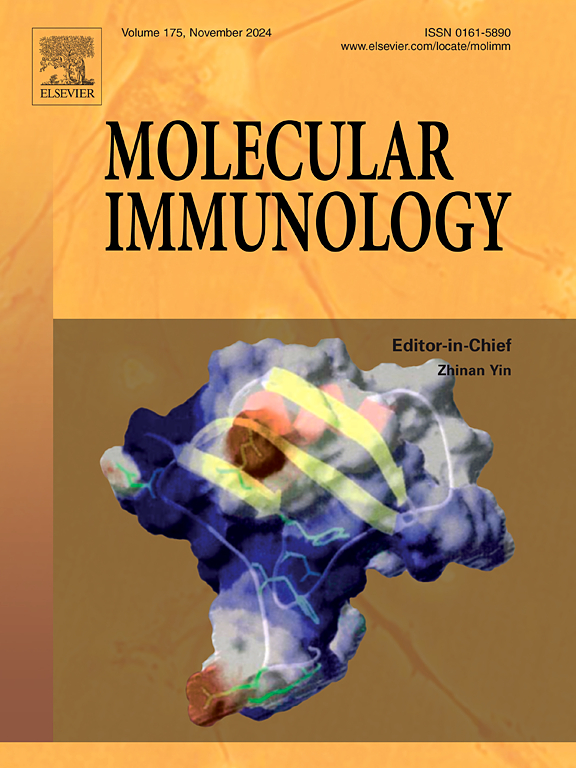DNA vaccination combined with immune checkpoint inhibition eradicates tumors, inducing life-long immunity against breast cancer in mice
IF 3
3区 医学
Q2 BIOCHEMISTRY & MOLECULAR BIOLOGY
引用次数: 0
Abstract
The employment of cancer vaccines as stand-alone or combined therapies has not yet reached clinically relevant endpoints in large clinical trials in the vast majority of patients, and there is a clear need for novel ideas and qualitatively new vaccine design approaches. In this study, we used a novel Variable Epitope Library (VEL) vaccine strategy, which incorporates thousands to millions of mutated variant epitopes within a combinatorial library, to target extreme variability and intratumoral heterogeneity of tumor antigens. A single intrasplenic vaccination with a VEL DNA vaccine encoding the amino-terminal region of mouse survivin, carrying eight mutated amino acid positions, induced significant tumor growth inhibition and suppression of lung metastasis in an aggressive and highly metastatic 4T1 triple-negative breast cancer (TNBC) preclinical model. Combining this vaccine with an immune checkpoint inhibitor (ICI) αCTLA-4 resulted in the elimination of established tumors, tumor-free survival of up to 412 days and life-long sterile immunity against tumor rechallenge in 77 % of mice. A significant increase in the number of CD3+ CD8+ Ly6C+ effector T cells in the lungs and spleens of vaccinated mice and the presence of central memory (TCM) and effector memory (TEM) T cells at different time points was documented. Likewise, the reduction of numbers of CD11b+ Ly6Cint Ly6G+ granulocytic myeloid-derived suppressor cells (G-MDSC) in vaccinated mice was observed. These data suggest that VEL immunogens are feasible candidates for inclusion/testing in clinical trials targeting multiple cancer types due to their universal nature.
DNA疫苗接种结合免疫检查点抑制根除肿瘤,在小鼠中诱导对乳腺癌的终身免疫
在绝大多数患者的大型临床试验中,采用癌症疫苗作为单独或联合治疗尚未达到临床相关终点,显然需要新的想法和新的疫苗设计方法。在这项研究中,我们使用了一种新的可变表位文库(VEL)疫苗策略,该策略在组合文库中包含数千到数百万个突变的变异表位,以靶向肿瘤抗原的极端变异性和肿瘤内异质性。在侵袭性和高转移性4T1三阴性乳腺癌(TNBC)临床前模型中,单次脾内接种编码小鼠survivin氨基末端区(携带8个突变氨基酸位置)的VEL DNA疫苗,可显著抑制肿瘤生长和肺转移。将该疫苗与免疫检查点抑制剂(ICI) αCTLA-4联合使用,可消除已建立的肿瘤,在77% %的小鼠中无肿瘤生存期可达412天,对肿瘤再攻击具有终身无菌免疫。接种疫苗小鼠肺和脾脏中CD3+ CD8+ Ly6C+效应T细胞数量显著增加,不同时间点存在中枢记忆(TCM)和效应记忆(TEM) T细胞。同样,在接种疫苗的小鼠中观察到CD11b+ Ly6Cint Ly6G+粒细胞髓源性抑制细胞(G-MDSC)的数量减少。这些数据表明,由于VEL免疫原的普遍性,它是针对多种癌症类型的临床试验中纳入/测试的可行候选物。
本文章由计算机程序翻译,如有差异,请以英文原文为准。
求助全文
约1分钟内获得全文
求助全文
来源期刊

Molecular immunology
医学-免疫学
CiteScore
6.90
自引率
2.80%
发文量
324
审稿时长
50 days
期刊介绍:
Molecular Immunology publishes original articles, reviews and commentaries on all areas of immunology, with a particular focus on description of cellular, biochemical or genetic mechanisms underlying immunological phenomena. Studies on all model organisms, from invertebrates to humans, are suitable. Examples include, but are not restricted to:
Infection, autoimmunity, transplantation, immunodeficiencies, inflammation and tumor immunology
Mechanisms of induction, regulation and termination of innate and adaptive immunity
Intercellular communication, cooperation and regulation
Intracellular mechanisms of immunity (endocytosis, protein trafficking, pathogen recognition, antigen presentation, etc)
Mechanisms of action of the cells and molecules of the immune system
Structural analysis
Development of the immune system
Comparative immunology and evolution of the immune system
"Omics" studies and bioinformatics
Vaccines, biotechnology and therapeutic manipulation of the immune system (therapeutic antibodies, cytokines, cellular therapies, etc)
Technical developments.
 求助内容:
求助内容: 应助结果提醒方式:
应助结果提醒方式:


